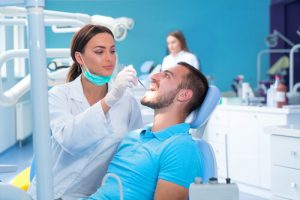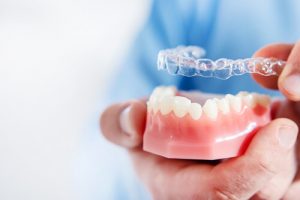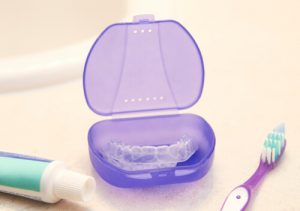
Can Invisalign fix crossbite? This question is at the forefront of many seeking an effective solution to their dental alignment challenges. As one of the most innovative advancements in orthodontic care, Invisalign offers a blend of aesthetic appeal and functionality. Join us as we delve into Invisalign’s capabilities, examining its effectiveness in treating various orthodontic conditions, including crossbite, and what makes it a preferred choice for many. Stay tuned to uncover whether this cutting-edge treatment can address your orthodontic needs.
Understanding Crossbite: Causes and Effects
A crossbite is a prevalent dental issue in which the alignment of the upper jaw and lower teeth disrupts the normal bite pattern. This condition, in which the upper teeth sit inside the lower teeth during closure, can significantly impact oral health and facial development if left untreated.
Causes of Crossbite
- Genetic Factors: Inherited discrepancies in jaw growth can predispose individuals to crossbite.
- Developmental Issues: Delayed loss of baby teeth or abnormal permanent teeth eruption can lead to misalignment.
- Habits Impacting Jaw Growth: Prolonged thumb sucking and mouth breathing are known to influence jaw shape and alignment.
- Facial Development: Improper facial development during critical growth can initiate or exacerbate a crossbite.
Effects of Crossbite
- Gum Disease and Bone Loss: A crossbite can increase the risk of periodontal issues and lead to jawbone deterioration.
- Wear on Teeth: Misaligned teeth may suffer from uneven wear, which can cause dental complications later.
- Chewing and Speech Issues: Difficulty chewing and alterations in speech clarity are common functional disruptions caused by crossbites.
- Aesthetic Concerns: Crossbites can affect facial symmetry and lead to noticeable aesthetic concerns.
An Overview of Invisalign Technology
Invisalign technology represents a significant advancement in orthodontics, offering a clear, flexible alternative to traditional metal braces. This innovative approach utilizes a series of custom-made, transparent aligners designed to move teeth into their proper position gradually. Here’s a deeper look into how Invisalign works and what makes it a preferred choice for many seeking orthodontic treatment:
Introduction to Invisalign Technology
Customized Aligners: Invisalign aligners are custom-created using 3D computer imaging technology to fit precisely and comfortably over the patient’s teeth. Each aligner is worn for roughly two weeks before being replaced with the next one in the series, gently nudging the teeth toward the planned alignment.
Key Features of Invisalign
- Aesthetically Pleasing: One of the most appealing features of Invisalign is its near invisibility, which makes it especially popular among adults and teens who prefer a more discreet orthodontic treatment option.
- Removability: Unlike traditional braces, Invisalign aligners can be easily removed for eating, brushing, and flossing. This routine allows for better oral hygiene and fewer dietary restrictions during treatment.
- Advanced Technology: Invisalign treatment plans are developed with advanced software that predicts the movement of teeth throughout treatment, allowing patients and orthodontists to visualize the outcome even before starting the process.
- Comfort and Safety: The aligners are made from a smooth, BPA-free plastic that doesn’t irritate the gums or cheeks, unlike the sharp edges of conventional braces.
Treatment Process
- Initial Consultation: The treatment begins with a consultation, where the orthodontist evaluates the patient’s teeth and discusses their goals. Impressions of the teeth are then taken to create a digital plan.
- Custom Treatment Plan: Each set of aligners is custom-made for the patient’s dental structure. As the treatment progresses, each new set of aligners takes the adjustment further.
- Regular Check-ups: Throughout the treatment, regular check-ups with the orthodontist to make sure that the treatment is proceeding as planned and adjustments are made as necessary.
Can Invisalign Fix Crossbite?
Yes, Invisalign clear aligners can effectively correct crossbites, particularly those with mild to moderate severity. This clear aligner technology is designed to shift teeth into proper alignment discreetly and comfortably. Using a series of custom-made, transparent aligners, Invisalign exerts controlled pressure on specific teeth, gradually moving them into the desired position.
However, the success of Invisalign in treating crossbites depends largely on patient compliance with wearing the aligners for the recommended 20-22 hours per day and the complexity of the individual’s dental issue. For severe crossbites or cases involving skeletal discrepancies, additional orthodontic interventions may be necessary.
Consulting with an orthodontist is crucial to determine if Invisalign is the right treatment option for your condition.
How Invisalign Treats Crossbite: The Process Explained
Invisalign technology has become a transformative tool in orthodontics, especially for treating conditions like posterior crossbite. This condition, where the upper teeth bite inside the other upper and lower jaw and teeth, can be addressed effectively with Invisalign’s custom aligners, which provide a less visible and more comfortable treatment alternative to traditional braces.
How Invisalign Treats Crossbite: The Process Explained:
- Customized Treatment Plan: Using sophisticated 3D imaging technology, Invisalign generates an accurate digital representation of the patient’s upper and lower teeth. This model serves as the basis for crafting a tailored treatment plan that outlines the sequential adjustments needed to rectify the crossbite.
- Gradual Movement of Teeth: Invisalign aligners apply controlled pressure to specific teeth that must be moved to correct the crossbite. This includes moving the upper teeth outward and the lower teeth inward to achieve the desired alignment.
- Sequential Aligner Changes: Patients receive a series of aligners, each slightly different from the last. Each aligner is worn for about two weeks before moving on to the next in the series, gradually shifting the upper front teeth into the correct position.
- Monitoring and Adjustments: Regular check-ups with an orthodontist ensure the treatment is progressing as planned. These visits are crucial for making necessary adjustments and replacing aligners as the teeth move into their new positions.
- Duration and Compliance: The overall length of treatment fluctuates based on the intensity of the crossbite and the patient’s adherence to wearing the aligners. For optimal results, aligners should be worn 20-22 hours daily.
Comparing Invisalign to Traditional Braces for Crossbite Correction
When considering orthodontic treatment for crossbite correction, the choice between Invisalign and traditional metal braces is significant. Each option offers distinct advantages and potential drawbacks, particularly regarding effectiveness, aesthetics, and the patient’s lifestyle compatibility.
Comparing Invisalign to Traditional Braces for Crossbite Correction:
Aesthetics and Visibility
One of the most observable differences between Invisalign and traditional braces is their aesthetic impact. Invisalign uses clear, plastic aligners that are unseen, making them a better choice for adults and teens who give more attention to their their appearance during orthodontic treatment. Traditional metal braces are more visible with their noticeable brackets and wires.
Comfort and Convenience
Invisalign aligners are known to be more comfortable than traditional braces because they are made from smooth plastic without sharp edges. Additionally, Invisalign aligners are removable, allowing for easier eating and oral hygiene practices. Traditional braces are attached to the teeth and can irritate the mouth’s soft tissues, requiring more meticulous cleaning around brackets and wires.
Treatment Complexity and Effectiveness
Traditional braces are often endorsed for more complex crossbite cases because they provide greater control over tooth movement, particularly in severe cases involving multiple teeth or significant jaw misalignment. While effective for mild to moderate crossbite corrections, Invisalign may not be suitable for more complicated alignments.
Treatment Duration
The duration of treatment with traditional braces and Invisalign can vary widely, but traditional braces are generally in place for 18-24 months, sometimes longer. Invisalign treatment might be shorter, depending on patient compliance, especially since the aligners must be worn for 20-22 hours daily to achieve the best results.
Follow-up and Adjustments
Invisalign patients visit their orthodontist every four to six weeks for follow-up appointments, whereas traditional braces may require more frequent adjustments. This can make Invisalign a more convenient option for patients with busy schedules.
Cost Considerations
Cost can be a deciding factor; traditional metal braces are often less expensive than Invisalign. However, prices vary significantly based on geographic location, specific treatment requirements, and the duration of use.
What to Consider Before Choosing Invisalign for Crossbite Treatment
Choosing Invisalign for crossbite treatment involves several considerations to ensure it’s the right option for your orthodontic needs. Here are key factors to think about before deciding to proceed with Invisalign aligners:
What to Consider Before Choosing Invisalign for Crossbite Treatment:
Severity of the Crossbite
Invisalign is highly successful for mild to moderate crossbite corrections, but more severe cases, particularly those involving skeletal discrepancies, might require more traditional orthodontic approaches, such as braces combined with orthodontic appliances. It is crucial to assess the complexity of your crossbite with an orthodontist.
Patient Compliance
Success with Invisalign depends heavily on the patient’s dedication to wearing the aligners for 20-22 hours recommended daily. Unlike conventional braces permanently attached to the teeth, Invisalign aligners can be removed. This flexibility requires a disciplined approach to ensure effective treatment.
Age and Dental Maturity
Invisalign is suitable for teenagers and adults whose teeth have reached a certain stage of development. Traditional braces might be a more effective option for children or early teenagers with developing teeth and jaws due to their robustness and non-reliance on patient compliance when wearing the device.
Lifestyle Considerations
Consider whether the removable nature of Invisalign aligners fits your lifestyle better than traditional braces. For example, if you routinely participate in contact sports, play wind instruments, or have an active social life, Invisalign’s removability can be a significant advantage.
Cost and Insurance Coverage
Typically, Invisalign can be more expensive than traditional braces. It’s important to consider your budget and check with your dental insurance provider to know what part of the treatment is covered and the out-of-pocket costs.
Treatment Duration
While Invisalign often promises a faster treatment period for mild to moderate dental issues, the actual duration can differ based on the complexity of the crossbite and how well the treatment protocol is followed. Discussing realistic expectations with your orthodontist can help set a clear timeline for your treatment.
In conclusion, whether Invisalign can fix crossbite effectively depends on individual cases, but it offers a promising solution for many. This clear aligner system provides a less invasive alternative to traditional braces, combining convenience with advanced technology to straighten teeth discreetly. If you’re considering Invisalign for crossbite correction, consulting with an orthodontist to evaluate your needs is crucial. Embrace the possibility of achieving a healthier, more aligned smile with Invisalign’s innovative approach.
References
Crossbite
https://www.invisalign.com/resources/treatable-cases/crossbite
Crossbite: Definition, Pictures, Causes, and Treatment
https://www.healthline.com/health/crossbite
Crossbite: Definition, Causes, and Treatment
https://www.verywellhealth.com/crossbite-5210091
Crossbite: Causes, Symptoms, and Treatment
https://www.webmd.com/oral-health/what-to-know-about-crossbite
Crossbite – an overview | ScienceDirect Topics
https://www.sciencedirect.com/topics/medicine-and-dentistry/crossbite









More Stories
Hairline Fracture in Tooth: Unveiling the Subtle Signs
Small Holes in Teeth That Aren’t Cavities: Understanding Enamel Erosion
Do Cavities Spread to Other Teeth?